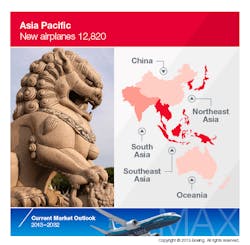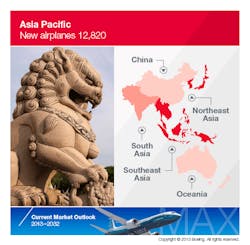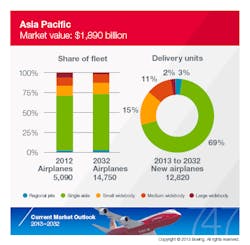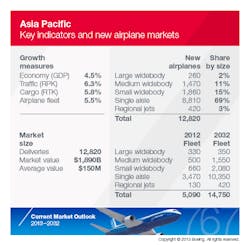Boeing forecasts $1.9 trillion in new airplanes in Asia Pacific over 20 years
SINGAPORE, 11 Feb. 2014. Strong economic and passenger growth will drive new airplane demand in the Asia Pacific region, according to Boeing [NYSE:BA] estimates. In fact, the region's airlines will account for 36 percent of the world's new airplane deliveries over the next 20 years, to the tune of 12,820 airplanes valued at $1.9 trillion, Boeing analysts predict.
"Over the next 20 years, nearly half of the world's air traffic growth will be driven by travel to, from or within the region," says Randy Tinseth, vice president, marketing, Boeing Commercial Airplanes, at the Singapore Airshow. “Asia Pacific economies and passenger traffic continue to exhibit strong growth. The Asia Pacific fleet will nearly triple, from 5,090 airplanes in 2012 to 14,750 airplanes in 2032, to support the increased demand."
Passenger airlines in the region will rely primarily on single-aisle airplanes, such as the Next-Generation 737 and the 737 MAX, to connect passengers; whereas single-aisle airplanes will represent 69 percent of the new airplanes in the region, according to Boeing's data.
"New low-cost carriers and demand for intra-Asia travel have fueled the substantial increase in single-aisle airplanes," Tinseth adds. "Fuel-efficient airplanes like the Next-Generation 737 and 737 MAX help the growing number of low-cost carriers operate more efficiently and provide affordable fares to the emerging middle class."
For long-haul traffic, Boeing forecasts twin-aisle airplanes, such as the 747-8 Intercontinental, 777m and the 787 Dreamliner, will account for 28 percent of new airplane deliveries. Boeing's recently launched 787-10 and 777X also will support the demand for fuel-efficient, twin-aisle airplanes in the region. Singapore Airlines has ordered 30 Boeing 787-10 airliners, and Cathay Pacific recently ordered 21 Boeing 777-9X airplanes.
Boeing data indicates the following trends:
Asia Pacific economies continue to exhibit strong growth. Intrinsic strength, progressive trade agreements among the region's countries, and recovering global demand are helping most economies in the region maintain healthy growth. Led by China and India, the region's economies will grow 4.5 percent per year over the next 20 years, outpacing the world's average growth rate. The region's share of world GDP will expand from 28 percent today to 36 percent by 2032.
During the next 20 years, nearly half of the world's air traffic growth will be driven by travel to, from, or within the Asia Pacific region. Total traffic for the region will grow 6.3 percent per year. Fueled by national economic growth and the increasing accessibility of air transport services, traffic within the region will grow faster than traffic to and from other regions. Domestic and international travel within the region will grow 6.5 percent per year.
Air cargo plays a critical role in the region's economy, transporting goods over difficult terrain and vast stretches of ocean. Some of the world's largest and most efficient cargo operators are located in Asia. The region's air cargo will grow 5.8 percent per year during the next 20 years. Carriers within the region are expected to take 370 new freighters, with an additional 490 conversions.
Asia Pacific airlines will need 12,820 new airplanes, valued at $1.9 trillion, over the next 20 years. The number of airplanes in the Asia Pacific fleet will nearly triple, from 5,090 airplanes in 2012 to 14,750 airplanes in 2032. New low-cost carriers and demand for intra-Asia travel have spurred a substantial increase in single-aisle airplanes, a trend that will continue as single-aisle airplanes gain an increasing percentage of the region's traffic.
The structure of the Asia Pacific airline industry is changing as regulations liberalize and carriers expand beyond national boundaries. Cross-border franchise agreements and direct investment in foreign carriers allow established airlines access to new markets and promote expanded air service to smaller markets. The growth of air travel as low-cost carriers reduce fares and open new markets testifies to the effects of liberalization. To compete, established airlines are forming low-cost enterprises, often through joint ventures with recognized LCCs. The improved affordability and accessibility of air travel will stimulate demand in established markets and meet emerging travel needs of the rising middle class.



